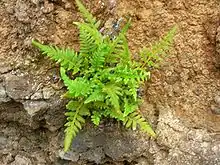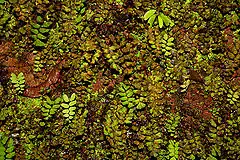Pteridaceae
Pteridaceae is a family of ferns in the order Polypodiales,[2] including some 1150 known species in ca 45 genera[3] (depending on taxonomic opinions), divided over five subfamilies.[4] The family includes four groups of genera that are sometimes recognized as separate families: the adiantoid, cheilanthoid, pteridoid, and hemionitidoid ferns. Relationships among these groups remain unclear, and although some recent genetic analyses of the Pteridales suggest that neither the family Pteridaceae nor the major groups within it are all monophyletic, as yet these analyses are insufficiently comprehensive and robust to provide good support for a revision of the order at the family level.
| Pteridaceae | |
|---|---|
 | |
| Pityrogramma austroamericana | |
| Scientific classification | |
| Kingdom: | Plantae |
| Clade: | Tracheophytes |
| Class: | Polypodiopsida |
| Order: | Polypodiales |
| Suborder: | Pteridineae J.Prado & Schuettp. |
| Family: | Pteridaceae E.D.M.Kirchn.[1] |
| Subfamilies | |
| Synonyms | |
| |
Description
Members of Pteridaceae have creeping or erect rhizomes. The leaves are almost always compound and have linear sori that are typically on the margins of the leaves and lack a true indusium, typically being protected by a false indusium formed from the reflexed margin of the leaf.
Taxonomy
Smith et al. (2006) carried out the first higher-level pteridophyte classification published in the molecular phylogenetic era.[5] Smith referred to the ferns as monilophytes, dividing them into four groups. The vast majority of ferns were placed in the Polypodiopsida.
In 2016, the Pteridophyte Phylogeny Group divided order Polypodiales into six suborders. Pteridaceae is the sole family in suborder Pteridiineae, with 52 genera. The suborder has the same circumscription as Smith et al. used for the family. The phylogenetic relationship between these six suborders is shown in this cladogram:[2]
| Polypodiales |
| ||||||||||||||||||||||||||||||
The oldest fossil of the family is Heinrichsia from the early Late Cretaceous (Cenomanian) aged Burmese amber of Myanmar, which cannot be assigned to modern grouping of the family. Molecular clock evidence suggests a diversification of the family during the Late Cretaceous.[6]
Traditional groups
_(8411478488).jpg.webp)
As traditionally defined, the groups within Pteridaceae are as follows:
- Adiantoid ferns (tribe Adianteae Gaudich. 1829[7]); epipetric, terrestrial or epiphytic in moist habitats, rachis often dichotomously branching; sori relatively small and discrete with sporangia born on the false indusium rather than the leaf blade proper; only one genus:
- Cheilanthoid ferns; primarily epipetric in semiarid habitats; leaves mostly with well-developed scales or trichomes, often bipinnate or otherwise highly compound; sporangia mostly born in marginal sori with false indusia that are +/- continuous around the leaf margins; several genera, including:
- Argyrochosma (J.Sm.) Windham – false cloak ferns
- Aspidotis (Nutt. ex Hook.) Copel. – lace ferns
- Astrolepis D.M.Benham & Windham – cloak ferns
- Cheilanthes Sw. – lip ferns
- Notholaena R.Br. – cloak ferns
- Pellaea Link – cliff brakes[8][9]
- Pteridoid ferns (tribe Pterideae J. Sm 1841[10]); terrestrial and epipetric in moist habitats; leaves mostly without prominent scales or trichomes, most often pinnate but sometimes more compound; sporangia born in marginal sori with false indusia that are +/- continuous around the leaf margins; several genera, including:
- Parkerioid ferns (tribe Parkerieae Brongn. 1843[11]); aquatic in swamps and/or mangroves, including:
- Acrostichum L. – leather ferns
- Ceratopteris Brongn.[8][9]
- Hemionitidoid ferns; terrestrial, epipetric or epiphytic in moist or semiarid habitats; leaves simple, pinnate, or more compound; sporangia born in linear non-marginal, exindusiate sori or sometimes in marginal sori; several genera, including:
- Anogramma Link
- Cryptogramma R.Br. – rock brakes
- Eriosorus Fée
- Hemionitis L.
- Jamesonia Hook. & Grev.
- Pityrogramma Link – gold ferns[8][9]
- Vittarioid ferns (tribe Vittarieae C. Presl 1836[12]); primarily epiphytic in tropical regions and all have simple leaves with sori that follow the veins and lack true indusia:
- Anetium Splitg. 1840
- Antrophyum Kaulf. 1875
- Hecistopteris (L.) Sm. 1842
- Monogramma Comm. ex Schkuhr 1809
- Vittaria (L.) Sm. 1793 – Shoestring fern
Subfamilies
Based on phylogenetic research, Christenhusz et al. (2011) divided the Pteridaceae genera into five subfamilies.[13] These roughly correspond with the groups listed above, with the main difference being that adiantoid and vittarioid ferns are combined under the Vittarioideae subfamily name. The approach was followed by the Pteridophyte Phylogeny Group classification of 2016 (PPG I).[2]
- Cryptogrammoideae S.Linds.
- Genera: Coniogramme, Cryptogramma, Llavea
- Parkerioideae (J.Sm.) R.M.Tryon
- Genera: Acrostichum, Ceratopteris
- Pteridoideae C.Chr. ex Crabbe, Jermy & Mickel
- Genera: Actiniopteris, Anogramma, Austrogramme, Cerosora, Cosentinia, Gastoniella, Jamesonia (incl. Eriosorus and Nephopteris), Onychium, Pityrogramma, Pteris (incl. Neurocallis & Platyzoma), Pterozonium, Syngramma, Taenitis, Tryonia
- Cheilanthoideae W.C.Shieh
- Genera: Adiantopsis, Aleuritopteris, Allosorus, Argyrochosma, Aspidotis, Astrolepis, Bommeria, Calciphilopteris, Cheilanthes, Cheiloplecton, Doryopteris, Gaga, Hemionitis, Lytoneuron, Mildella, Myriopteris, Notholaena, Ormopteris, Paragymnopteris, Parahemionitis, Pellaea, Pentagramma, Trachypteris
- Vittarioideae (C.Presl) Crabbe, Jermy & Mickel
Distribution and habitat
Mostly terrestrial or epipetric (growing on rock).
References
- "Family: Pteridaceae E. D. M. Kirchn". Germplasm Resources Information Network. United States Department of Agriculture. 2001-08-14. Archived from the original on 2012-05-27. Retrieved 2011-11-04.
- Pteridophyte Phylogeny Group 2016.
- Christenhusz, M. J. M. & Byng, J. W. (2016). "The number of known plants species in the world and its annual increase". Phytotaxa. 261 (3): 201–217. doi:10.11646/phytotaxa.261.3.1.
- Christenhusz, M. J. M. & Chase, M. W. (2014). "Trends and concepts in fern classification". Annals of Botany. 113 (4): 571–594. doi:10.1093/aob/mct299. PMC 3936591. PMID 24532607.
- Smith et al. 2006.
- Regalado, Ledis; Schmidt, Alexander R.; Müller, Patrick; Niedermeier, Lisa; Krings, Michael; Schneider, Harald (July 2019). "Heinrichsia cheilanthoides gen. et sp. nov., a fossil fern in the family Pteridaceae (Polypodiales) from the Cretaceous amber forests of Myanmar". Journal of Systematics and Evolution. 57 (4): 329–338. doi:10.1111/jse.12514. ISSN 1674-4918.
- Adianteae Tropicos.org. Missouri Botanical Garden. 14 Jan 2012
- "Pteridaceae". Integrated Taxonomic Information System. Retrieved 2011-11-04.
- "GRIN Genera of Pteridaceae". Germplasm Resources Information Network. United States Department of Agriculture. Archived from the original on 2015-09-24. Retrieved 2011-11-04.
- Pterideae Tropicos.org. Missouri Botanical Garden. 14 Jan 2012
- Parkerieae Tropicos.org. Missouri Botanical Garden. 14 Jan 2012
- Vittarieae Tropicos.org. Missouri Botanical Garden. 14 Jan 2012
- Christenhusz, Maarten J. M.; Zhang, Xian-Chun; Schneider, Harald (18 February 2011). "A linear sequence of extant families and genera of lycophytes and ferns" (PDF). Phytotaxa. 19: 7–54. doi:10.11646/phytotaxa.19.1.2. ISSN 1179-3163.
- Schuettpelz & Pryer (2008) "Fern phylogeny" in Biology and Evolution of Ferns and Lycophytes, ed. Tom A. Ranker and Christopher H. Haufler. Cambridge University Press 2008
- Schuettpelz et al. (2007) Archived 2008-08-20 at the Wayback Machine Eric Schuettpelz, Harald Schneider, Layne Huiet, Michael D. Windham, Kathleen M. Pryer: "A molecular phylogeny of the fern family Pteridaceae: Assessing overall relationships and the affinities of previously unsampled genera." Molecular Phylogenetics and Evolution 44 (2007) 1172–1185
Bibliography
- Chase, Mark W.; Reveal, James L. (2009). "A phylogenetic classification of the land plants to accompany APG III". Botanical Journal of the Linnean Society. 161 (2): 122–127. doi:10.1111/j.1095-8339.2009.01002.x.
- Christenhusz, M. J. M.; Zhang, X. C.; Schneider, H. (18 February 2011). "A linear sequence of extant families and genera of lycophytes and ferns". Phytotaxa. 19 (1): 7. doi:10.11646/phytotaxa.19.1.2.
- Christenhusz, Maarten J.M.; Chase, Mark W. (2014). "Trends and concepts in fern classification". Annals of Botany. 113 (4): 571–594. doi:10.1093/aob/mct299. PMC 3936591. PMID 24532607.
- Christenhusz, Maarten JM & Byng, J. W. (2016). "The number of known plants species in the world and its annual increase". Phytotaxa. 261 (3): 201–217. doi:10.11646/phytotaxa.261.3.1.
- Lehtonen, Samuli (2011). "Towards Resolving the Complete Fern Tree of Life". PLoS ONE. 6 (10): e24851. doi:10.1371/journal.pone.0024851. PMC 3192703. PMID 22022365.
- Pryer, Kathleen M.; Schneider, Harald; Smith, Alan R.; Cranfill, Raymond; Wolf, Paul G.; Hunt, Jeffrey S.; Sipes, Sedonia D. (2001). "Horsetails and ferns are a monophyletic group and the closest living relatives to seed plants". Nature. 409 (6820): 618–622. doi:10.1038/35054555. PMID 11214320.
- Pteridophyte Phylogeny Group (November 2016). "A community-derived classification for extant lycophytes and ferns". Journal of Systematics and Evolution. 54 (6): 563–603. doi:10.1111/jse.12229.
- Ranker, Tom A.; Haufler, Christopher H., eds. (2008). Biology and Evolution of Ferns and Lycophytes. Cambridge University Press. ISBN 978-0-521-87411-3.
- Schneider, Harald; Schuettpelz, Eric; Pryer, Kathleen M.; Cranfill, Raymond; Magallón, Susana; Lupia, Richard (1 April 2004). "Ferns diversified in the shadow of angiosperms". Nature. 428 (6982): 553–557. doi:10.1038/nature02361. PMID 15058303.
- Schneider, Harald; Smith, Alan R.; Pryer, Kathleen M. (1 July 2009). "Is Morphology Really at Odds with Molecules in Estimating Fern Phylogeny?". Systematic Botany. 34 (3): 455–475. doi:10.1600/036364409789271209.
- Smith, Alan R.; Kathleen M. Pryer; Eric Schuettpelz; Petra Korall; Harald Schneider; Paul G. Wolf (2006). "A classification for extant ferns" (PDF). Taxon. 55 (3): 705–731. doi:10.2307/25065646. JSTOR 25065646.
- Smith, Alan R.; Pryer, Kathleen M.; Schuettpelz, Eric; Korall, Petra; Schneider, Harald; Wolf, Paul G. Fern classification (PDF). pp. 417–467., in Ranker & Haufler (2008)
- Eric Schuettpelz. The evolution and diversification of epiphytic ferns. PhD Thesis Duke University 2007
- Michael Hassler and Brian Swale. Checklist of Ferns and Fern Allies 2001
- Australian National Botanic Gardens. A classification of the ferns and their allies
External links
![]() Data related to Pteridaceae at Wikispecies
Data related to Pteridaceae at Wikispecies
| Wikimedia Commons has media related to Pteridaceae. |
